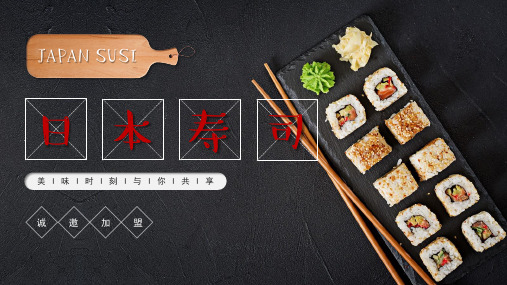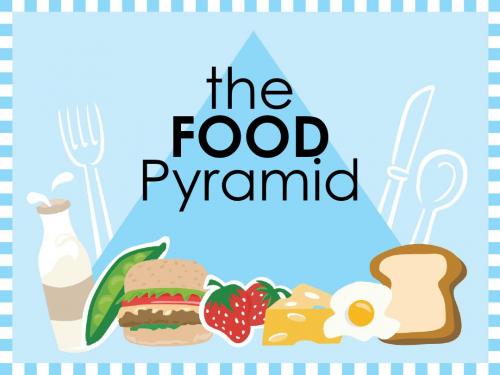食物介绍PPT模板
美食料理传统美食美味佳肴美食小吃演示PPT模板

注重食材新鲜、烹饪技巧高超、 口感丰富多样、地域特色鲜明。
美食料理发展历程
古代美食料理
起源于古代宫廷和民间,以传统烹饪 手法和食材为主,注重色香味形俱佳 。
现代美食料理
吸收现代烹饪技术和国际餐饮文化, 不断创新发展,形成多元化、时尚化 的美食风格。
美食料理分类及地域特色
分类
按烹饪技法可分为炒、炖、煮、炸等;按食材可分为肉类、海鲜、蔬菜等;按 口味可分为酸甜苦辣咸等。
1 2 3
融合创新
当代美食料理注重跨界融合,将不同菜系、烹饪 技艺和食材进行巧妙组合,创造出新颖独特的菜 品。
健康养生
随着健康意识的提高,当代美食料理更加注重营 养均衡、低脂低糖、天然有机等方面,满足人们 对健康养生的需求。
科技智能化
科技手段在美食料理中的应用日益广泛,如智能 烹饪设备、分子料理技术等,为美食创作提供了 更多可能性。
创新尝试
鼓励创新尝试,将不同地域、不 同风味的小吃进行搭配和融合。
品尝体验分享
感官体验
从色、香、味、形等方面全面感受小吃的美味。
文化体验
了解小吃背后的历史文化和地域特色,增加品尝的乐趣。
分享交流
与朋友、家人分享品尝体验,共同感受美食带来的快乐。
05 美食料理文化传承与创新 发展
美食料理在文化传承中作用
艺术呈现
通过雕刻、拼摆等手法,将佳肴呈 现为艺术品,令人赏心悦目。
名厨佳作欣赏
名厨介绍
烹饪心得分享
介绍国内外知名厨师及其代表作品, 领略大师级烹饪风采。
分享名厨们的烹饪心得与经验,为观 众提供学习与借鉴的机会。
佳作展示
展示各类美食佳作,包括传统名菜、 创新佳肴等,激发观众的美食热情。
食品介绍PPT模板

正确加工食品
在加工食品前要注意清洗双手和食材,生熟食品要分开处理和存放,避免交叉污染。烹饪时要煮熟煮透,避免食用未煮熟的食品。
消费者如何保障自身饮食安全
THANKS
感谢您的观看。
介绍生产过程中的质量控制措施,如原料检验、半成品检验和成品检验等。
质量控制措施
对产品进行安全性评估,包括添加剂使用、农药残留、重金属含量等方面的检测和分析,确保产品的安全性。
安全性评估
介绍产品的标签和包装要求,包括标签内容、包装材料和包装方式等,确保产品的合规上市。
食品标签与包装
产品质量控制与安全性评估
根据产品类型和工艺要求,选择适合的加工方法,如炒制、腌制、烘焙等。
设备介绍
详细介绍加工过程中所使用的设备,包括其功能、特点和使用注意事项。
工艺流程图
通过流程图展示整个加工过程,使观众更加直观地了解产品的生产流程。
加工方法与设备介绍
明确产品的质量标准和要求,包括感官指标、理化指标和微生物指标等。
质量标准
食品介绍PPT模板
目录
食品概述 各类食品特点及营养价值 食品加工技术与工艺 食品包装与储存技术 现代食品科技发展趋势 食品安全与卫生管理
01
CHAPTER
食品概述
指各种供人食用或者饮用的成品和原料以及按照传统既是食品又是中药材的物品,但是不包括以治疗为目的的物品。
食品定义
包括谷类、薯类、豆类、蔬菜、水果、肉类、蛋类、奶类、水产品、调味品、饮料、酒类等。
纳米包装材料
利用纳米技术制备具有抗菌、抗氧化、防潮等功能的食品包装材料,提高食品的保质期和安全性。
纳米技术在食品中的应用
数字化工厂
通过工业互联网、大数据等技术手段,构建数字化工厂,实现食品生产过程的可视化、可追溯和智能化管理。
中国美食概述PPT模板

烹饪技法的多样性
炒、炖、炸、蒸、煮等技法
01
03
05
炒的技巧与要点
火候掌控,快火快炒
02
炖的艺术与火候
文火慢炖,入味滋养
炸的原理与方法
高温短时,外酥里嫩
04
蒸的技巧与窍门
保持原味,营养健康
煮的深度与时间
水开煮制,熟透而不烂
美食文化的地域特色
各地风味的独特 魅力
川菜的麻辣传奇
麻、辣、鲜、香,味型丰富,口感独特
减少食物浪费的责 任与行动
合理采购与储存,减少食物 浪费,实现循环利用。
绿色烹饪的定义与 意义
采用环保的烹饪方法,减少 对环境的污染。
节能减排的烹饪工 具与技术
使用节能厨具,减少能源消 耗,保护环境。
传统与现代烹饪技 艺的融合创新
结合传统烹饪智慧与现代环 保技术,创造绿色美食。
中国美食的代表菜品
各地佳肴与世界闻名
运用粤菜独特的炖煮方式,火候掌 控讲究。
鲍鱼炖鸽的风味特色
鲍鱼鲜美与鸽肉鲜嫩相结合,呈现 粤菜特色。
北京烤鸭
中西合璧的烤鸭魅力
01
02
03
04
05
历史渊源
1. 源远流长的饮食文化象征
制作工艺
1. 选材严格,烤制讲究,技 艺传承
风味独特
1. 皮脆肉嫩,香气扑鼻,味 道独特
中西融合
1. 西方食用方式,增添烤鸭 魅力
粤菜的精细讲究
选料讲究,清淡爽口,色香味俱佳
苏菜的温婉雅致
讲究火候,汤鲜味美,刀工精细
传统与现代烹饪技艺
传承与创新的美食发展
现代烹饪技艺的探索与应用
创新菜品的研发
结合现代口味与传统元素,开发 新菜品。
各类食物的营养价值PPT教学课件

2)其他豆类:蛋白质含量中等,为20%-25%;脂 肪含量较低为1%左右,碳水化合物含量较高,在 55%以上。维生素和矿物质的含量也很丰富。
2020/12/10
5
(2)豆类蛋白质、脂肪和碳水化合物的 组成特点
豆类蛋白质中含有人体需要的全部氨基酸, 属于完全蛋白,其中赖氨酸含量较多,但 蛋氨酸较少,因此利用率较低。
(2)蔬菜的合理选择 蔬菜含丰富的维生素,除抗坏血酸 外,一般叶部含量比根茎部高,嫩叶比枯叶高,深色的菜 叶比比浅色的高.应注意选择新鲜,色泽深的叶菜类.
2020/12/10
9
(四)菌藻类营养素含量特点
菌藻类食物包括食用菌和藻类食物.富含 蛋白质,膳食纤维,碳水化合物,维生素和 微量元素.蛋白质含量以发菜,香菇和蘑菇 中最为丰富,在20%以上.脂肪含量低,约 1.0 %左右,碳水化合物含量为20%- 35%, 银耳和发菜中的含量较高,达35%左右.硫 胺素和核黄素含量也比较高.微量元素含 量丰富,尤其是铁,锌和硒,其含量是其他 食物的数倍甚至十余倍.在海产食植物中, 如海带,紫菜等中还含丰富的碘,每100g海 带中碘含量可达24mg.
2)脂肪:谷类脂肪含量较低,但脂肪组 成中多不饱和脂肪酸含量较高。如玉米油 中不饱和脂肪酸含量达85%左右,其中油 酸为36.5%,亚油酸占47.8%,亚麻酸占0.5%
3)碳水化合物:谷类的碳水化合物绝大部分 是以淀粉的形式存在,并且以支链淀粉为主.
2020/12/10
4
(二)豆类及其制品的营养价值及合理利用
叶菜类是胡萝卜素,核黄素,抗坏血酸和矿物质及膳 食纤维良好来源,在绿叶蔬菜和橙色蔬菜中较为丰 富,特别是胡萝卜素的含量较高.蛋白质含量较低,一 般为1%-2%,脂肪含量不足1%,碳水化合物含量为 2%-4%,膳食纤维约1.5%.
日本寿司美食介绍PPT模板

中国的烹饪,不仅技术精湛,而且有讲究菜肴美感的传统,注意食物的色、香、味、形、器的协调一致。
中国的烹饪,不仅技术精湛,而且有讲究菜肴美感的传统,注意食物的色、香、味、形、器的协调一致。
请在此添加您的文字内容,请在此添加您的文字内容。请在此添加您的文字内容,请在此添加您的文字内容。请在此添加您的文字内容,请在此添加您的文字内容。请在此添加您的文字内容,请在此添加您的文字内容。
寿司介绍
请在此添加您的文字内容,请在此添加您的文字内容。请在此添加您的文字内容,请在此添加您的文字内容。
请在此添加您的文字内容,请在此添加您的文字内容。请在此添加您的文字内容,请在此添加您的文字内容。
感
谢
观
看
诚邀加盟
美食介绍
2
日本常说"有鱼的地方就有寿司",这种食物据说来源于亚热带沿海及海岛地区,那儿的人发现,如果将煮熟的米饭放进干净的鱼膛内,积在坛中埋入地下,便可长期保存,而且食物还会由于发酵而产生一种微酸的鲜味,这也就是寿司的原型。
请在此添加您的文字内容,请在此添加您的文字内容。请在此添加您的文字内容,请在此添加您的文字内容。请在此添加您的文字内容,请在此添加您的文字内容。请在此添加您的文字内容,请在此添加您的文字内容。
寿司特色
寿司特色
美食介绍
3
日本常说"有鱼的地方就有寿司",这种食物据说来源于亚热带沿海及海岛地区,那儿的人发现,如果将煮熟的米饭放进干净的鱼膛内,积在坛中埋入地下,便可长期保存,而且食物还会由于发酵而产生一种微酸的鲜味,这也就是寿司加您的文字内容。请在此添加您的文字内容,请在此添加您的文字内容。
食品行业产品介绍通用PPT模板

维生素B
水果含有丰富的维 生素、食物纤维等 营养成分
橙子
食物纤维
水果含有丰富的维 生素、食物纤维等
营养成分
青柠檬
水果含有丰富的维生素、食物纤维 等营养成分,能够帮助消化,有益 于身体健康
水果含有丰富的 维生素、食物纤 维等营养成分
优点
口味和营养都比较好 符合人体健康需要
特点
通过人工栽培管理
有机蔬菜
营养物质
主要包含矿物质、维 生素、纤维
研究表明
人每天至少要食用 1000克左右的蔬菜
食用功效
营养、防癌、美肤、 瘦身
绿色蔬菜
营养物质
提供人体所必需的多 种维生素和矿物质等
营养物质
健康食品
蔬菜可提供人体所必 需的多种维生素和矿
物质等营养物质
LOGO
绿色健康食品
Green healthy organic food 健康首选/绿色有机/吃得放心
水
蔬
肉
果
菜
类
篇
篇
篇
Green food of the fruit
健康饮食之水果篇
水果含有丰富的维生素、食物纤维等营养成 分,能够帮助消化,有益于身体健康
菠萝
水果含有丰富的维生素、食物纤维 等营养成分,能够帮助消化,有益 于身体健康
猕猴桃
水果含有丰富的 维生素、食物纤 维等营养成分
水果含有丰富的 维生素、食物纤 维等营养成分
Green food of vegetables
健康饮食之蔬菜篇
蔬菜是人们日常饮食中必不可少的食物之 一。蔬菜可提供人体所必需的多种维生素 和矿物质等营养物质
地方特色美食山西面食介绍PPT模板

剔尖
• 剔尖儿,顾名思义是把做拨鱼儿的手法变更了。剔尖儿拨下去的面浆不带两头尖, 而成了短短的细面条(比投鱼儿的条子约长一倍,有三四寸长的样子)。
• 相传,唐朝贞观年间,唐王李世民有一叔妹,名唤世姑,在山西介休县境内的绵山 上诵经修行。一日,世姑为一患病的老妪边配药,边做饭,因自幼生长在皇宫,不 曾学会做饭,无奈,软了加面,硬了加水,最后,还是将面活成了稀软,无法擀, 只好将面贴在盘子里,用一根尖头筷子试着往开水锅里拨,竟然拨成了粗细均匀的 一根根面条。老妪吃的上口,就问世姑“这叫什么?”,世姑因心慌,听成了“你 叫什么”便随口把乳名说成了“八姑”,老 妇误听成“拨股”,因“拨股面”是 鱼肚形,所以有人亦叫他为“拨鱼儿”,又因面条呈两头尖,又有成为“剔尖”。
目录 CONTENT
01.山西面食文化简介
02.山西各种面食介绍
03.山西面食图片欣赏
PART 01 山西面食文化简介
山西面食文化简介
山西面食,历史悠久,迄今至少有两 千年的文化传统,且在中国独树一帜。
自古以来,晋人主食乃面食,以花 样多,品质好,影响大而颇为出名,故海 内外早有“世界面食在中国,中国面食在 山西”的说法。东到娘子关,西到黄河边, 南到风陵渡,北到雁门关,一般家庭妇女 都能以面粉为原料加工数种面食。
山西面食在东汉称之为“煮饼”; 魏晋则名为“汤饼”;南北朝谓“水引”; 而唐朝叫“冷淘”……。面食名称推陈出 新,因时因地而异,俗话说娇儿宠称多, 面食众多的称谓与名堂,正说明山西人对 它的重视和喜爱。
山西面食文化简介
山西境内名吃(美食)种类繁多,而且内容十分丰 富。
面食在山西按照制作工艺来讲,可分为蒸制面食 煮制面食、烹制面食三大类,有据可查的面食 在山西就有280种之多,其中尤以刀削面名扬 海内外,被誉为中国著名的五大面食之一。其 他如大拉面、刀拨面、拨鱼、剔尖、河捞、猫 耳朵、蒸、煎、烤、炒、烩、煨、炸、烂、贴、 摊、拌、蘸、烧等多种,名目繁多,让人目不 暇接。 另外还有太原“认一力”蒸饺、平遥牛 肉、太谷饼、闻喜煮饼、芮城麻片、太原羊杂 割汤、灌肠,高平烧豆腐、介休贯馅糖、忻州 瓦酥、平阳泡泡糕都有独特风味,是名吃中上 品。,
各类食物的营养价值讲义模版(PPT64张)

谷皮 13-15 19
33
42
谷胚 2-38源自6426胚乳 83
70-75 3
32
86
50
73
2
7
21
12
43
6
2.1 谷类种子的营养价值
▪ 谷类种子是碳水化合物的丰富来源,其中淀粉含量 达70%以上。谷类种子中尚含有少量葡萄糖、糊精 和戊聚糖。
药膳与中国饮食文化
生命科学与技术学院 田学军 教授
第七章 各类食物的营养价值
一、 食物营养价值的评价与意义
1.1 食物营养价值的相对性 食物的功能
营养功能 感官功能 生理调节功能
营养价值的相对性:
①几乎所有天然食物中都含有人体所需要的一种以上的营 养素。
②不同的食物中热能和营养素的含量不同,但同一种食物 的不同品种、不同部位、不同产地、不同成熟程度之间 也有相当大的差别。
▪ 谷类种子的蛋白质含量在7%-16%之间 。
谷类蛋白质的特点: 醇溶蛋白(也称麦胶蛋白)和谷蛋白的含量高,白蛋白和球蛋
白含量少。 醇溶蛋白中缺乏赖氨酸,赖氨酸是谷类的第一限制氨基酸,
色氨酸和苏氨酸的含量也偏低,使得谷类蛋白质的生物价 值较低。 燕麦和荞麦的蛋白质中赖氨酸十分丰富,生物价值较高。 玉米蛋白质以醇溶谷蛋白为主,缺乏粮氨酸,色氨酸也不 足,生物价值较低。 小麦含有几乎等量的谷蛋白和醇溶蛋白 。 谷类的脂肪含量低,一般仅有2%~3%,主要集中干外层的 胚、糊粉层和谷皮部分。
③食物的营养价值也受储存、加工和烹调的影响。 ④有些食物中存在一些天然抗营养因素或有毒物质。 ⑤食品的安全性是首要的问题。
1.2 食物营养素密度与平衡膳食
11 卡通食物介绍PPT模板

What are discretionary calories? Discuss how many discretionary calories children should
eat every day. Solicit class feedback for examples of ways to use
the FOOD Pyramid
Eating Right Every Day
Briefly describe the point of this lesson, which is that the class will be learning about the relationship between good nutrition and health.
Vegetables
Vary your veggies
List a few examples of vegetables that are plentiful in your area.
Discuss how much children should eat every day and when they might have them.
The Food Pyramid
Steps to a healthier you
GRAINS
VEGETABLES
FRUITS
OILS
MILK
MEAT & BEANS
Grains
Make half of your graples of grains that are plentiful in your area.
fruits. Encourage children to list foods that they like from this
中国传统美食汤圆介绍PPT模板

营养价值
甜馅汤圆本身已有甜味,所以汤不需要再加糖,以减少热量摄取;若是无馅小汤圆,汤可以用糖桂花、甜酒酿、花茶或者桂圆红枣汤、桂圆姜汤取代,后者可有补身祛寒的功效;煮咸汤圆时可放一些蔬菜,增加纤维素。
营养价值
配点辣菜护脾胃。汤圆含糖特别高,而太甜的食物会影响脾胃。中医说“甘入脾”,味甘的食物如汤圆,有“缓滞”作用,适量摄取能为肠胃带来能量,帮助消化吸收吃进肚子里的食物
中国传统美食汤圆
Traditional Chinese food dumplings
据传,汤圆起源于宋朝。当时的明州(现浙江省宁波市)所兴起的一种新奇食品,即用黑芝麻、猪板油做馅、加入少许白糖,外面用糯米粉搓成圆形,煮熟后,吃起来香甜软糯,回味无穷。同时,汤圆象征合家团圆美满,吃汤圆也意味着在新的一年里合家幸福、团团圆圆,所以是正月十五元宵节必备美食。
特色汤圆
汤圆文化
特色汤圆
PART THREE
吃汤圆是汉族人的传统习俗,在江南尤为盛行。民间有“吃了汤圆大一岁”之说。陈志岁《汤圆》诗云:“年年冬至家家煮,一岁潜添晓得无” 地俗语云:“宁波家家捣米做汤圆,知足常乐又一天。”
特色汤圆
特色汤圆
特色汤圆
特色汤圆
鸡屎藤汤圆:鸡屎藤为叶类蔓薯植物,生长在热带潮湿的灌木丛之下,能够入药,具有清热、消炎、解毒、润肺醒脑的功效,民间叫土参。这种植物又能制作风味美食。鸡屎藤汤圆是三亚地区富有特色的风味小吃。北京元宵:原料:面粉、糯米面、白糖、核桃仁、 糕丁、瓜子仁、花生、红绿丝、杏仁、芝麻(黑,白)、奶油、花生油等等,取其中的几样,配方多种多样。镇雄汤圆:汤圆汤圆,顾名思义应该都是圆的。镇雄汤圆却偏偏不是圆的,当然我说的是真正本土的镇雄汤圆,至于县城里被异地同化了的圆形汤圆,并非本土汤圆。雪中送炭:所谓雪,就是汤圆雪白的外层,而炭则是内层的炭烧朱古力馅,汤圆味道较浓,所以就配一个清新的玫瑰花汤底,喝一口汤,吃一口汤圆,就是最佳的吃法哦。
牛肉知识介绍PPT模板

目
录
牛
牛
牛
肉
肉
肉
的
的
的
基
选
食
础
购
用
知
知
方
识
识
法
第一章
牛肉的基础知识
beef
唯有美食不可辜负
牛肉是全世界人都爱吃的食品,在我们日常消费中, 仅次于猪肉,牛肉蛋白质含量高,而脂肪含量低,所 以味道鲜美,受人喜爱,享有“肉中骄子”的美称,
因此冬季是人们餐盘中常见的食物。
牛肉的营养价值
Steak Ready Strip Loin-前腰脊肉,含有些许脂肪,是最 适合用于煎烤的牛排部位,在美国俗称就叫纽约客(NEW YORKER)。在肉的外延带一圈呈白色的肉筋,总体口感韧 度强,肉质硬,有嚼头,适合年轻人牙口好的人吃。
丁骨(T-Bone)
带骨的前腰脊肉,因为带T字形肋骨而得其名,在骨头的两 边一边是菲力,一边是沙朗,由于可以同时吃到两个部位 的肉所以价格也较为昂贵。Porter House-红屋牛排,就 是大丁骨牛排,是指丁骨牛排中肉量面积最大的部份。
Nutr ition
食含含含含含
用钙锌高维维
多、、蛋生生
样铁镁白素素
化
质
和
钾
B6 B12
肉牛的种类
30-36
75 18-24
预 期
谷 的 谷 在 可 料 到 定 当 是
玉物大能进饲体小采
的
米饲多快行养重牛用
收月。料数地育场时食圈
获龄谷含情长肥再,用养
体之饲有况到,喂它牧方
重间牛高下成使食们草式
饲 肉 牛
唯
带骨牛小排
有
美
食物金字塔 空白PPT模板

食物金字塔建立科学的饮食观念正确的每日饮食简单介绍本课的要点:均衡的营养与健康的关系食物金字塔肥肉,食用油,甜品节制肉,禽,鱼,豆,蛋,坚果类2-3 份牛奶,酸奶,奶酪类2-3 份蔬菜类3-5 份水果类2-4 份面包,谷类,大米,面食类6-11 份水果列出几种本地区大量拥有的水果讨论每天同学们应该吃多少,可在什么时候吃 调查并讨论水果给健康带来的好处鼓励同学们列出他们喜欢吃的水果蔬菜列出几种本地区大量拥有的蔬菜讨论每天同学们应该吃多少,可以在什么时候吃 调查并讨论蔬菜给健康带来的好处鼓励同学们列出他们喜欢吃的蔬菜肉、豆、坚果 列出几种本地区大量拥有的肉、豆和坚果讨论每天同学们应该吃多少,可以在什么时候吃调查并讨论肉、豆和坚果给健康带来的好处鼓励同学们列出他们喜欢吃的肉、豆和坚果牛奶、酸奶、奶酪列出几种本地区大量拥有的牛奶、酸奶和奶酪讨论每天同学们应该吃多少,可以在什么时候吃调查并讨论牛奶、酸奶和奶酪给健康带来的好处鼓励同学们列出他们喜欢吃的牛奶、酸奶和奶酪面包及面类食品 列出几种本地区大量拥有的面包及面类食品讨论每天同学们应该吃多少,可以在什么时候吃调查并讨论面包及面类食品给健康带来的好处鼓励同学们列出他们喜欢吃的面包及面类食品肥肉、食用油、甜品 列出几种本地区大量拥有的肥肉、食用油和甜品讨论每天同学们最多可以吃多少调查并讨论多吃油脂和甜品给健康带来的危害请同学们对这类食物提出自己的意见和看法零食列出几种零食讨论同学们每天可以吃多少零食请同学们找出其他有利于健康的零食正确饮食,保持健康!鼓励同学们每日记录自己的当天饮食,记录一周。
鼓励同学们每类食物都要吃一些,以便满足身体的需求周末讨论他们的记录及发现每个同学是否可以吃得更健康一些结论总结每类食物对健康的好处鼓励同学们对食物与健康的关系进行研究鼓励同学们继续记录每日饮食请校医向同学们介绍食物与健康之间的关系的真实事例。
食品课件ppt模板

THANKS
感谢观看
控制食量
控制食量是保持健康的重要措施,避 免过量摄入高热量食物,保持适当的 能量平衡。
04
食品加工与保存
食品加工技术
食品加工技术
介绍食品加工的基本原理和技术 ,包括切割、混合、加热、冷却 等工艺流程,以及不同加工技术 对食品品质和营养成分的影响。
食品加工设备
介绍各种食品加工设备,如切割机 、搅拌机、烤箱等,以及它们在食 品加工中的应用和优缺点。
食品加工安全
强调食品加工过程中的卫生和安全 问题,包括防止食品污染、交叉感 染、食物中毒等方面的注意事项。
食品保存方法
食品保存原理
介绍食品保存的基本原理,包括 食品腐败和变质的原因、微生物
的生长和繁殖等。
食品保存方法
介绍各种食品保存方法,如冷藏 、冷冻、真空包装、干燥等,以 及它们对延长食品保质期的作用
食品的分类
总结词
食品分类是根据食品的来源、生产方式、加工方式、形状、口感、营养成分等特点,将食品进行分类的方法。
详细描述
食品分类有助于人们更好地了解各类食品的特点和营养价值,方便食品的生产、加工、销售和使用。常见的食品 分类方法包括按照来源分类、按照生产方式分类、按照加工方式分类、按照形状分类、按照口感分类和按照营养 成分分类等。
根据产品类型、消费群体 、销售渠道等维度,将食 品市场细分为多个子市场 。
食品市场趋势
个性化、健康、绿色、智 能成为未来食品市场的发 展方向。
消费者行为与心理
消费者需求分析
消费者对食品的需求呈现 多样化、个性化趋势,注 重口感、营养、安全等方 面。
蔬菜PPT模板

果实类蔬菜
西红柿
黄瓜
含有丰富的维生素C、胡萝卜素、番茄红素 等,具有生津止渴、健胃消食、清热解毒 、凉血平肝等功效。
含有多种维生素和矿物质,具有清热解毒 、利水消肿、美容养颜等作用。
茄子
辣椒
含有蛋白质、脂肪、碳水化合物、维生素 以及钙、磷、铁等多种营养成分,具有清 热解暑、降脂降压、抗衰老等作用。
播种与育苗
根据蔬菜种类和生长要求,选择合适 的播种时间和方式,进行育苗管理, 确保出苗整齐、健壮。
蔬菜的生长周期
发芽期
从播种到出苗,一般需 要适宜的温度和湿度条
件。
幼苗期
从出苗到定植,需要进 行适当的间苗、移栽等
管理。
生长期
蔬菜在此阶段进行营养 生长和生殖生长,需要 加强田间管理,确保生
长良好。
成熟期
蔬菜的搭配与禁忌
搭配
根据蔬菜的营养成分和口感,进 行合理的搭配,如叶菜类搭配根 茎类,豆类搭配谷类等。
禁忌
避免将某些蔬菜与相克的食物一 起食用,如菠菜与豆腐、黄瓜与 西红柿等。
蔬菜的食用注意事项
清洗干净
食用前需将蔬菜彻底清洗干净 ,去除农药残留和细菌。
适量食用
蔬菜虽好,但也要适量食用, 避免摄入过多导致消化不良。
蔬菜的营养价值
01
02
03
维生素
蔬菜是维生素的重要来源 ,特别是水溶性维生素, 如维生素C和B族维生素。
矿物质
蔬菜中含有丰富的矿物质 ,如钙、铁、锌、钾等, 对维持人体正常生理功能 具有重要作用。
膳食纤维
蔬菜中的膳食纤维有助于 促进肠道蠕动,改善消化 功能,预防便秘等肠道问 题。
餐饮美食烧烤PPT模板

01
此处添加标题
02
此处添加标题
03
此处添加标题
04
此处添加标题
录入上述图表的综合描述说明, 录入上述图表的综合描述说明, 录入上述图表的综合描述说明, 录入上述图表的综合描述说明,
录入上述图表的综合描述说明, 录入上述图表的综合描述说明, 录入上述图表的综合描述说明, 录入上述图表的综合描述说明,
标题
标题
标题
标题
第二部分
MOISTUIZING MASK SKIN CARE
Your content to play here, or through your copy, paste in this box, and select only the text.Your content to play here, or through your copy, paste in this box, and select only the text. Your content to play here, or through your copy, paste in this box, and select only the text.
01
输入您的内容或者通过右键复 制粘贴您的内容,并选择只保 留文字。输入您的内容。
02
输入您的内容或者通过右键复 制粘贴您的内容,并选择只保 留文字。输入您的内容。
03
输入您的内容或者通过右键复 制粘贴您的内容,并选择只保 留文字。输入您的内容。
04
输入您的内容或者通过右键复 制粘贴您的内容,并选择只保 留文字。输入您的内容。
03.请输入您标题
这里可以输入可长可短的段落文字这里可以输入可长可短的段落文字这里可以输入 可长可短的段落文字
美食PPT模板PPT课件

美食的历史与文化
中国美食的历史渊源
自古以来,中国就是一个具有丰富美食文化的国家,不同地区、不同民族都有自 己独特的饮食文化和传统。
美食文化的交流与发展
随着时代的发展,不同地区、不同国家的饮食文化也在相互交流、融合,形成了 丰富多彩的世界美食文化。
美食的分类与特点
中餐
中国菜系,具有独特的烹饪技巧和 口味,注重色、香、味、形、器的 和谐统一。
创新与融合
在传承传统美食的同时,也需要不断地创新和融合。现代厨师们通过结合现代烹饪技艺和食材,不断 地为传统菜品注入新的元素,使其焕发出新的生命力。例如,在传统川菜中加入现代元素,使得菜品 更加丰富多彩。
现代美食的发展趋势
健康饮食
随着人们对健康的重视程度不断提高,健 康饮食成为了现代美食发展的趋势之一。 厨师们更加注重食材的营养搭配和健康烹 饪方式的选择,例如低油、低盐、低糖等 。
感谢您的观看
THANKS
01
总结与展望
总结美食文化的传承与发展
美食文化的发展历史
从古至今,美食文化经历了漫长的发展过程,逐渐பைடு நூலகம்成了各种具 有地方特色的菜系。
传统烹饪技巧的传承
传统的烹饪技巧和手法是美食文化的重要组成部分,这些技巧和 手法在传承过程中逐渐发展完善。
食材与营养的演变
随着人们对食材和营养的认识不断深入,美食文化也在不断地演 变和升级。
感受。
美食不仅满足游客的口腹之欲 ,还能让游客了解当地的饮食 文化和风俗习惯,丰富旅游体
验。
美食在旅游中的地位逐渐提升 ,成为吸引游客的重要因素之
一。
国内外著名美食旅游胜地介绍
国内
四川的火锅、广东的早茶、北京的烤鸭、上海的小笼 包等都是国内著名的美食旅游胜地,各具特色,风味 独特。
- 1、下载文档前请自行甄别文档内容的完整性,平台不提供额外的编辑、内容补充、找答案等附加服务。
- 2、"仅部分预览"的文档,不可在线预览部分如存在完整性等问题,可反馈申请退款(可完整预览的文档不适用该条件!)。
- 3、如文档侵犯您的权益,请联系客服反馈,我们会尽快为您处理(人工客服工作时间:9:00-18:30)。
The Moving Target of Nutrition
Annette Maggi, MS, RD, LD, FADA Sr. Director of Nutrition NuVal LLC
2
3
4
5
6
Sounding the Alarm
Frightening rise in obesity holds deadly implications for health
• KIDS aged 2-18 get 400 calories a day from beverages:
– 162 from milk – 121 from soda – 112 from 100% fruit juices and fruit drinks – In kids age 14-18, soda, sports and energy drinks are the highest
Iron
13
Use of one algorithm allows shoppers to compare products both within a product category and across an eating occasion, even if in different areas of the store
Saturated fat Trans fat Sodium Sugar Cholesterol
Vitamin B12
Vitamin B6 Potassium Calcium
Generally Favorable Nutrients
= Generally Less Favorable Nutrients
• High fructose corn syrup (HFCS) has been more vilified than any other food ingredient and without solid reasoning. This sweetener is processed from corn, and is about 45-55% glucose and 45-55% fructose. While it has been suggested that HFCS has contributed to obesity, science does not support this claim.
8
The Quality of the Calories We Consume
• The AVERAGE ADULT (19+) gets 394 calories a day from beverages:
– 114 from soda – 108 from alcohol (someone is getting my share on most days!) – 80 from fluid milk – 67 from 100% fruit juice and juice drinks – 26 from coffee and tea
1990
Obesity Rates:
1998
2010
Out-of-control trends signal the need to bring clear guidance to consumers on matters of health and nutrition.
7
The Quality of the Calories We Consume
14
NuVal® Scores Clarify Commonly Held Myths
NuVal® Score
Zinc
Omega-3 fatty acids Total bioflavonoids Total carotenoids Magnesium
The scoring algorithm is grounded in the 2005 Dietary Guidelines for Americans, FDA/USDA regulations, and evidence-based science
contributor of calories.
9
Sweeteners: Natural vs. Added
• Table sugar is the common, powdered white stuff. Structurally, it is called a disaccharide, a double sugar. In the body, it is broken down to 50% glucose and 50% fructose.
10
Sugars: Natural vs. Added
NUTRIENT DENSITY
The NuVal® Algorithm
Numerator ÷ Denominator = Score of 1 to 100
Fiber Folate Vitamin A Vitamin C Vitamin D Vitamin E
